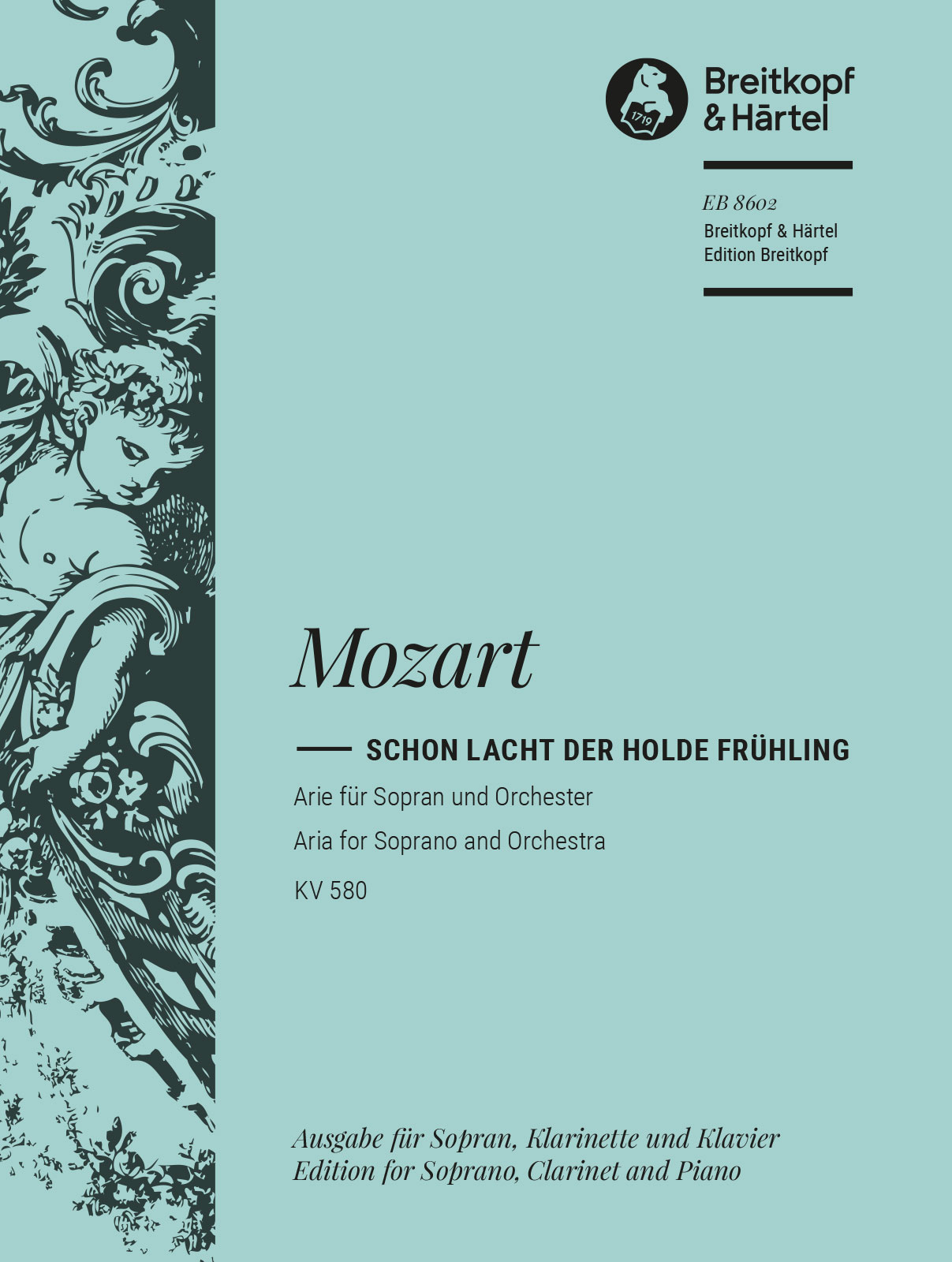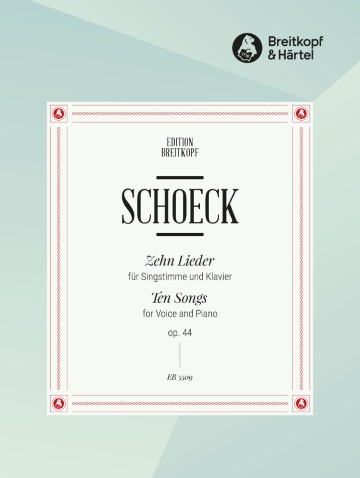“Schon lacht der holde Frühling” KV 580
Aria – Completion of the Fragment

Composer: Mozart, Wolfgang Amadeus
Arranger: Beyer, Franz
Arranged for: Soprano, Clarinet and Piano
Publisher:
| Product Code: | 979-0-004-81354-6 |
| ISMN: | 979-0-004-81354-6 |
| Publishers Number: | EB 8602D |
| Orchestration: | solo: S – 0.0.2.2. – 2.0.0.0. – str |
| Page count: | 22 |
| Condition: | New |
In his adolescent years, Mozart’s creative output and technical command of music rapidly evolved, setting new standards for the art form. His early works, composed under the bright lights of European audiences, combined technical brilliance with an intimate emotional depth. Whether drafting lively sonatas or elaborate symphonies, Mozart’s compositions sparkled with a refined elegance that was both accessible and sophisticated. His ability to blend innovation with classical form revolutionized the musical world. In the vibrant salons and opera houses of his time, audiences were treated to works that pushed the boundaries of traditional composition, introducing new dynamics, intricate counterpoints, and a playful use of melody that still resonates today. This period of experimentation not only solidified his reputation as a prodigious talent but also laid the groundwork for the many masterpieces that would emerge in his later life.
While Mozart’s early works laid a strong foundation, it is his mature compositions that truly define his legacy. In operas such as “The Marriage of Figaro,” “Don Giovanni,” and “The Magic Flute,” Mozart showcased his ability to blend humour, drama, and human emotion into a tapestry of sound that captured the complexities of human nature. Each opera is a masterful amalgamation of libretto, orchestration, and vocal prowess, revealing a deep understanding of the human condition that is both timeless and universally appealing. Mozart’s symphonies and concertos further extend his genius, featuring layers of tonal beauty and structural innovation that challenge and inspire musicians and audiences alike. His music, characterized by its clarity, balance, and emotional depth, continues to evoke powerful responses, transcending the confines of time and geography to touch listeners worldwide.
Beyond his technical brilliance, what truly sets Mozart apart is the sheer emotional range and expressive power embedded in his works. His compositions often move effortlessly between moments of joyful exuberance and profound melancholy, reflecting the duality of life itself. Despite living a relatively short life—Mozart passed away at the young age of 35—his musical output was incredibly prolific, leaving behind a legacy of over 600 works that span every genre of his era. The enduring popularity of these works is a testament to their universal appeal. Whether performed in grand concert halls or intimate chamber settings, Mozart’s music continues to inspire both seasoned musicians and new audiences. His ability to convey complex human emotions through the language of music creates a bridge between cultures and eras, making his art as relevant today as it was centuries ago.
Mozart’s profound influence on the evolution of Western music is undeniable. His innovative approach to composition redefined the possibilities of musical structure and storytelling, paving the way for future generations of composers. Many of Mozart’s contemporaries and successors, including Ludwig van Beethoven and Franz Schubert, were deeply inspired by his work, incorporating aspects of his style into their own compositions. Moreover, Mozart’s deft handling of form and structure has been studied by music scholars and educators for generations, with his works serving as quintessential examples of balance, clarity, and ingenuity. Today, his music is not only a staple of the classical repertoire but also a living document of the creative spirit that propelled the Classical era into modern consciousness.
In reflection, Mozart’s life and music embody the pinnacle of artistic expression, where technical mastery meets emotional sincerity in a celebration of life’s intricacies. His journey from a precocious child prodigy to a mature, innovative composer is a narrative filled with both brilliance and poignant struggle, providing insight into the nature of genius itself. Even though Mozart’s life was tragically brief, his relentless pursuit of excellence in every musical endeavor left behind an oeuvre that continues to evoke admiration and introspection. As listeners and performers alike delve into the intricate techniques and heartfelt emotion woven throughout his compositions, they not only experience the beauty of the music but are also reminded of the timeless connection between art and human experience. Mozart’s story is a continuous call to embrace creativity and passion, inspiring generations to push beyond conventional boundaries in their own artistic pursuits.
Mozart’s enduring genius forever continues to inspire music lovers worldwide.
The "Köchel" still lists the autograph to Mozart’s beloved aria but has labeled it "missing" since 1964. The "Neue Mozart-Ausgabe" was thus no longer able…
“Eine Aria in die Oper, der Balbier von Seviglien. für Madme Hoffer. 2 Violini, viole, 2 Clarinetti, 2 Fagotti, 2 Corni e Baßi. Schon lacht der holde Frühling.” This entry in Wolfgang Amadeus Mozart’s handwritten work catalogue is found under the date 17 September 1789. However, since the projected performance of a German arrangement of Paisiello’s Barbiere was apparently abandoned, Mozart seems to have put aside the piece without finishing it. Josepha Hofer (nee Weber), Constanze Mozart’s youngest sister, was to have sung this aria, intended for Rosina. As a member of Schikaneder’s Freihaustheater, she sang the Queen of the Night at the first performance of the Magic Flute.
In addition to the vocal part, the fragmentary score contains only the bass line as well as instrumental cues for a future orchestration. The editor’s orchestrally supplemented version, issued by the same publisher, is based on the autograph preserved in the Österreichische Nationalbibliothek in Vienna. This autograph was rediscovered only in 1988. We pursued our endeavor to provide a Mozartian sound in the instrumental completion of the score while preparing this arrangement for soprano, clarinet and piano. Since the first clarinet repeatedly weaves around the soprano part in thr orchestral version, it seemed perfectly natural to producc the present arrangement. Moreover, it will inevitably bring to mind Franz Schubert’s Der Hirt auf dem Felsen (same key, middle section in G minor).
We wish to thank the Österreichische Nationalbibliothek in Vienna for putting copies of the source at our disposal.
Munich, Spring 1997
R.R.P 18
Our Price: 15
Digital Download – PDF
Please create and forward a copy of this publication to the customer
You might also like
-
10 Lieder Op. 44
£26.00 -
15 Selected Songs
£28.00 -
2 Songs
£17.00 -
3 Wishes from a Rose
£29.00




